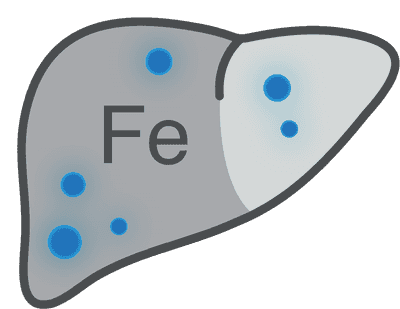Understanding Hemochromatosis Iron Overload
Blog

Iron is an essential mineral that your body needs to carry oxygen and keep your organs functioning; however, excessive intake can be harmful. Hemochromatosis, commonly known as iron overload, is a condition where excess iron builds up in the body and damages the organs over time.
The gastroenterologists at NYGA are here to explain everything you need to know about hemochromatosis.
What Is Hemochromatosis?
Definition of hemochromatosis
Hemochromatosis is when the body absorbs and stores excessive amounts of iron from food. Usually, your intestines absorb only as much iron as the body needs. In hemochromatosis, this regulation doesn’t work properly, leading to iron accumulation in the liver, heart, pancreas, and other organs.
Types of hemochromatosis
- Hereditary hemochromatosis (primary): The most common type is caused by genetic mutations, most often in the HFE gene, which affects how the body regulates iron.
- Secondary hemochromatosis: Develops due to another condition, such as chronic liver disease, certain types of anemia, or repeated blood transfusions.
- Juvenile hemochromatosis: A rare form that appears in adolescence or early adulthood, often leading to more severe organ damage.
- Neonatal hemochromatosis: An extremely rare condition in newborns where iron rapidly builds up in the liver.
Symptoms of Hemochromatosis
Early warning signs
In the early stages, symptoms may be vague and often mistaken for other conditions. These can include:
- Fatigue or weakness
- Joint pain, particularly in the hands
- Abdominal pain
- Unexplained weight loss
Long-term effects
If left untreated, iron buildup can cause severe damage over time:
- Liver disease, including cirrhosis or liver cancer
- Heart problems, such as arrhythmias or heart failure
- Diabetes, due to damage to the pancreas
- Skin changes, including a bronze or gray tone
- Arthritis in larger joints
When to see a doctor
If you have a family history of hemochromatosis, persistent fatigue, or signs of liver disease, it’s important to get evaluated. Early diagnosis can prevent long-term organ damage.
How Hemochromatosis Is Diagnosed
Blood tests
Initial testing often includes measuring serum ferritin (a measure of iron stores) and transferrin saturation (the amount of iron in the blood). Elevated levels suggest iron overload.
Liver function tests
Iron buildup often affects the liver first; liver function tests, such as liver elastography, help assess damage. In some cases, imaging, such as MRI or a liver biopsy, may be recommended to measure iron content directly.
Gene testing
Genetic testing can confirm hereditary hemochromatosis by identifying mutations in the HFE gene. This test is beneficial for patients with a family history of the condition.
Hemochromatosis Treatment Options
Phlebotomy
The standard treatment for hereditary hemochromatosis is regular phlebotomy or blood removal. By drawing blood at set intervals, iron levels gradually decrease, and once normalized, patients may only need occasional maintenance treatments.
Iron chelation
For patients who cannot undergo phlebotomy, for example, those with anemia, iron chelation therapy may be used. Medications bind to excess iron, allowing it to be excreted in the urine or stool.
Lifestyle changes
Certain lifestyle modifications can help manage hemochromatosis:
- Avoiding iron supplements and multivitamins containing iron
- Limiting vitamin C supplements, which increase iron absorption
- Reducing or eliminating alcohol intake to protect the liver
- Maintaining a balanced diet low in red meat and high in whole grains, vegetables, and fruits
Conclusion
Hemochromatosis can be silent in its early stages, but over time, iron overload may cause serious complications if untreated. The good news is that with timely diagnosis and effective management, patients can lead full, happy lives.
At NYGA, our gastroenterologists use advanced testing to identify iron overload and provide personalized treatments to protect your long-term health. If you suspect you may have hemochromatosis, or if it runs in your family, schedule an appointment today to take control of your digestive and overall wellness.
Don’t wait. Prioritize your health today.
